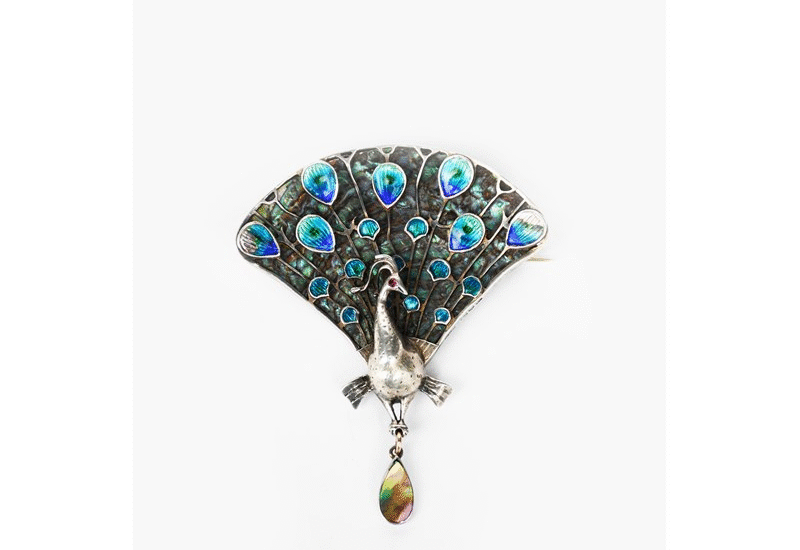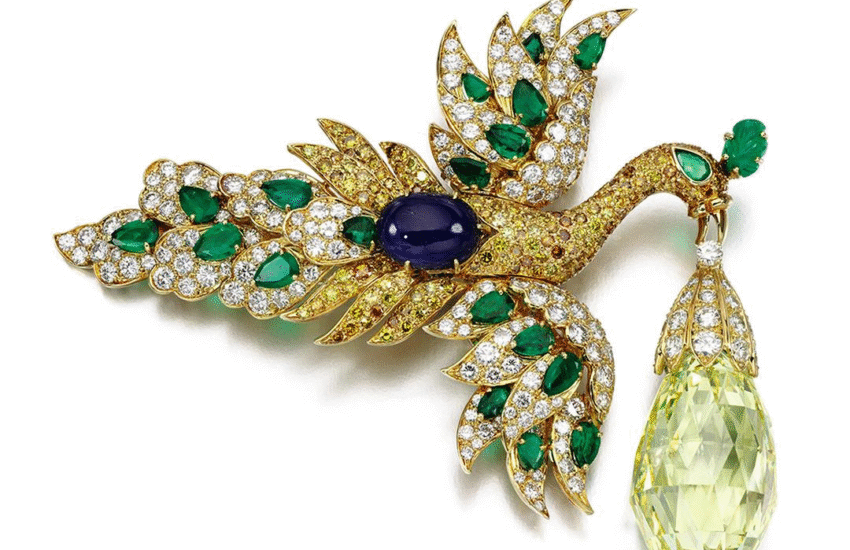1944: Jewellery and the liberation of Paris
80 years ago this year, on the 26th of August 1944, Général de Gaulle paraded down the Champs-Élysées with the tanks of the liberating Allied forces. Paris wasn’t just the capital of France, it was the European centre for culture, literature and fashion. Freeing Paris saw the end of four years of painful occupation by the armies of Nazi Germany and was an important turning point in the Second World War. Just as jewellery played a part in the resistance of the French, the liberation of Paris was celebrated with fabulous jewellery.
Although constrained by shortage of raw materials and the tragic arrest and deportation of many of Jewish jewellers and stone cutters, Paris jewellery firms often continued to work, if in a reduced capacity, during the years of occupation. Consequently, when freedom was regained, they were ready to create celebratory jewels using the symbolism and visual language of the war.
Paris is under the sign of wings
Birds became the jewelled symbol both of resistance and of the joy of renewed freedom. The famous bird-cage jewels designed by Pierre Lemarchand for Cartier are perhaps the most iconic jewels of French resistance. These brooches and pendants, showing a bird trapped inside a locked cage, were a clear metaphor for the plight of Parisians and displaying them in the Cartier shop window was a brave provocation to the German occupiers. Although Cartier stayed open during the war years, they clearly did not entirely support their new Nazi clientele.
On the left, the 1942 jewel shows the cage door closed while the later bird, in the red, white and blue of the French flag, is triumphantly perched by the open door.

French fashion magazine Fémina suspended publication during the war years due to lack of paper and a wish not to legitimise life under occupation. However, May 1945 saw their triumphant return under the slogan ‘Vive Paris!’
As they told their readers, 1945 should be placed under the sign of wings and their magazine illustrates this – a jewelled red, white and blue bird pulls back the curtain while Cartier’s bird brooch at the bottom shows the blue bird of happiness opening the cage door to liberate its friend.
Le jeep de la Liberation
Allied jeeps draped in the French, British and American flags driving through the streets of Paris were an unmistakable symbol of freedom. Mauboussin turned this into jewellery in 1945. Their ‘Jeep de la Liberation’ jewels were the glamorous symbol of regained liberty.


Mauboussin’s 18 carat gold jeep is driven by a tiny soldier, dwarfed by the enormous sapphire, diamond and ruby French tricolore flag. The French flag was completely banned in the occupied zones so, replacing the Nazi flag with the French was the key moment of liberation for many French towns and cities. It’s not surprising that there was such a keen appetite for jewellery decorated with the tricolore!
Some versions of the jeep jewel were topped with patriotically coloured flowers, perhaps referring to the flowers placed on passing jeeps by grateful local people.
Image courtesy of Sotheby’s.
Van Cleef and Arpels’ Victory jewels
Van Cleef and Arpels also created their versions of victory jewels. The ‘Broche de la Victoire’ was a finely made piece of gold, platinum and the usual red, white and blue gemstones. Diamonds created a ‘V for Victory’ shape, made famous by Winston Churchill, amongst others.

The sapphire double armed Croix de Lorraine was not so much a religious symbol as the famous sign of the Alsace-Lorraine region, a point of contention and invasion during both world wars. It became the official symbol of the Free French government and a sign of secret support for resistants in France.
Image from the Petit Palais, Musée des Beaux Arts de la Ville de Paris.

The Van Cleef and Arpels designers may have taken their inspiration from the designs used by Resistance magazines, like the front cover of L’espoir, which shows the Croix de Lorraine placed inside a victorious letter V.
The same Lorraine cross was used on the Ordre de la Libération, the decoration created by De Gaulle in 1940 to honour those who fought to liberate France. The insignia was designed by Lieutenant Tony Mella and made by the London branch of Cartier for the exiled Free French government.
Van Cleef and Arpels took all the symbols of liberation, including the plentiful cigarettes and chewing gum which made American soldiers so popular, to create a lapel chain hung with charms. It’s like wearing the liberation of Paris draped across your jacket.

Home made adornments
Not everyone could afford the jewellers of the Rue de la Paix, but many still wanted to express their feelings through fashion. Make do and mend jewellery had often been the only option for French women. Even if you could only manage painted wood or crocheted wool earrings and pendants, you could still join in the celebrations.
The Yorkshire Post described the joyous scenes in 1944 Paris:
Thousands cycled into the heart of the city to take part in the liberation celebrations.
The women looked as lovely and elegant as ever they did in the old days. Clothing is dear by any standards, but many of them had clearly contrived their own dresses, for they were in bright patriotic colours. These colours they matched with earrings and with the bows in their childrens’ hair.
The Yorkshire Post and Leeds Intelligencer, 28 August 1944, p.1

Thirty year old Marguerite Sabaud made herself a red, white and blue dress decorated with Parisian monuments as well as a pair of crocheted earrings. She chose the cocarde shape made famous in the French revolution, in the patriotic colours which were so fashionable and appropriate.
Image from the Musée de la Libération de Paris.
Souvenirs for the boys
For many men, war offered their first opportunity to travel abroad and among all the fear and suffering, there was also the opportunity to visit new places. Naturally, they sought out souvenirs for themselves and gifts to send home.
This little brooch by the French jewellery firm of Victor Linton must be one of the fastest bits of war merchandising possible. Accessorised with the inevitable French flag, it must have resembled many of the letters sent to the girls back home.
It’s a charming little object, clearly aimed at the visiting American GI who wanted a present for ‘Miss Sweetheart’ back in the USA.

A postcard tucked into the back of the brooch reads:
“Paris 1944, Hello Darling I’m doing my best to come back soon. Gee! my heart is like a bomb when I think of you Keep smiling,Your lonely boy“
Image from the Musée de la Libération de Paris.
What girl wouldn’t be won over by this?

Looking at the Paris Liberation through jewellery
We might think that people would be too busy with the serious questions of war to bother with jewellery and fashion but jewels have always followed the trends of history and jewellery can be a vital way to keep up spirits, express political and cultural identity and even show secret signs of resistance to occupation.
Parisian jewellers chose to use their art form to commemorate a vital moment in history, using the daily sights of war to make beautiful and moving objects.


This is fascinating. Thank you.
What a lovely article! Thank you so much for your well-researched story.
Thank you – so pleased you enjoyed it!
It was interesting to see how Jewelry could show secret signs of resistance to occupation.
Thank you for this very thoughtful article